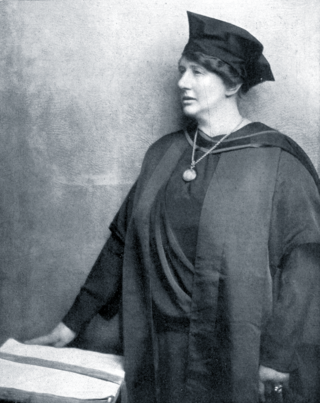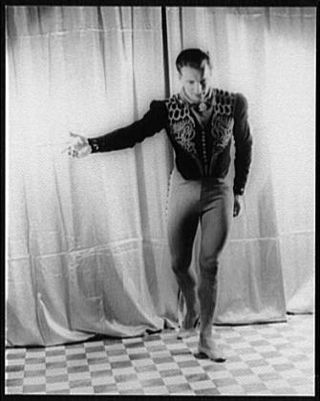
The following outline is provided as an overview of and topical guide to theatre:

The Opéra Bastille is a modern opera house in the 12th arrondissement of Paris, France. Inaugurated in 1989 as part of President François Mitterrand's Grands Travaux, it became the main facility of the Paris National Opera, France's principal opera company, alongside the older Palais Garnier; most opera performances are shown at the Bastille along with some ballet performances and symphony concerts, while Palais Garnier presents a mix of opera and ballet performances.

Lilian Mary Baylis CH was an English theatrical producer and manager. She managed the Old Vic and Sadler's Wells theatres in London and ran an opera company, which became the English National Opera (ENO); a theatre company, which evolved into the English National Theatre; and a ballet company, which eventually became The Royal Ballet.
Strictly, digital theatre is a hybrid art form, gaining strength from theatre's ability to facilitate the imagination and create human connections and digital technology's ability to extend the reach of communication and visualization.

Antony Tudor was an English ballet choreographer, teacher and dancer. He founded the London Ballet, and later the Philadelphia Ballet Guild in Philadelphia, Pennsylvania, U.S., in the mid-1950s.

Sir Kenneth MacMillan was a British ballet dancer and choreographer who was artistic director of the Royal Ballet in London between 1970 and 1977, and its principal choreographer from 1977 until his death. Earlier he had served as director of ballet for the Deutsche Oper in Berlin. He was also associate director of the American Ballet Theatre from 1984 to 1989, and artistic associate of the Houston Ballet from 1989 to 1992.
Stephen Robert Dixon is a British actor and academic.

Ping Chong is a Canadian-born American contemporary theatre director, choreographer, video and installation artist. Born in Toronto and raised in the Chinatown section of Manhattan, Chong is a creator of and an early pioneer in interdisciplinary theater work and the integration of media into it. Chong is considered a seminal figure in Asian American theatre and the Asian American arts movement.
DV8 Physical Theatre was a physical theatre company based at Artsadmin in London, United Kingdom. It was officially founded in 1986 by Lloyd Newson (1986–2015), Michelle Richecoeur (1986–1988) and Nigel Charnock. Lloyd Newson led the company as choreographer and artistic director from its inception, apart from the production My Sex, Our Dance (1986), which was co-created and performed with Nigel Charnock. DV8 officially ended in April 2022 when Lloyd Newson announced his retirement via the company web page.
Restless Dance Theatre, formerly Restless Dance Company, is a dance theatre company based in the South Australian capital of Adelaide. Founded in 1991, Restless works with people with and without disability.

Pilobolus is an American modern dance company that began performing in October 1971. Pilobolus has performed over 100 choreographic works in more than 64 countries around the world, and has been featured on the 79th Annual Academy Awards, The Oprah Winfrey Show and Late Night with Conan O'Brien.
Chamber Made, formerly known as Chamber Made Opera, is an Australian arts organisation based in Melbourne, creating work operating at the intersections of music, sound and contemporary performance.

S. Ama Wray, known formally as Sheron Wray, is a professor of dance at the University of California, Irvine, USA. She is a British dancer, teacher, choreographer and theatre director. She studied under Jane Dudley at the London Contemporary Dance School. She later performed with the London Contemporary Dance Theatre and the Rambert Dance Company before forming her own company called JazzXchange in 1992. She is presently an associate professor of dance at the Claire Trevor School of the Arts at the University of California, Irvine.
The physically integrated dance movement is part of the disability culture movement, which recognizes and celebrates the first-person experience of disability, not as a medical model construct but as a social phenomenon, through artistic, literary, and other creative means.
Digital Performance refers to the use of computers as an interface between a creator, consumer of images, and sounds in a wide range of artistic applications. It is performance that incorporates and integrates computer technologies and techniques. Performers can incorporate multimedia into any type of production whether it is live on a theatre stage, or in the street. Anything as small as video recordings or a visual image classifies the production as multimedia. When the key role in a performance is the technologies, it is considered a digital performance. This can be as simple as making projections on a screen for a live audience or as complex as planning and putting on a show online.

Ballet Pixelle is a ballet company founded in 2006 by choreographer Inarra Saarinen. Saarinen still serves as artistic director and choreographer. Ballet Pixelle is the first dance company to perform completely in virtual reality. Its goal is to explore and extend physical and virtual dance and movement and to blend those realities.
Lloyd Newson is a director, dancer and choreographer. He formed DV8 Physical Theatre and has led the company since its inception in 1986. He studied psychology and social work at Melbourne University and after graduating began his dancing career in New Zealand, initially as a dancer but later also as a choreographer.
Theatre Gargantua is a Toronto-based theatre company founded by Artistic Director Jacquie P.A. Thomas in 1992. The company emphasizes artist collaboration, both within Canada and globally, combining a range of artistic disciplines to create new work. The defining experimental style of Theatre Gargantua's productions are a hybrid of Thomas' studies in Europe, which include creation as an artistic collective, an extended development phase, imagistic production elements, original composition often performed live and choreographed physicality of performers. The topics of exploration in Gargantua's past shows have been grounded in social issues, creating compelling work that is presented through highly physical performances.
Stacy Makishi is a Hawaiian-born performance artist, physical theatre and live art specialist. Her work often involves combining autobiographical experience and comedy with inspiration from fictional sources, such as Hollywood movies or novels. She has been identified by The Guardian as part of a new generation of artists making 'innovative shows [. . .] with and by young people'.

Santee Smith Tekaronhiáhkhwa is a Canadian Mohawk multidisciplinary artist, dancer, designer, producer, and choreographer. She has used her voice and research to create dance works representing Indigenous identities. She is an advocate for Indigenous performances and is one of Canada's most dominating dance artists. Santee Smith has amassed multiple awards throughout her career and in 2019, she was appointed Chancellor of McMaster University in Hamilton, Ontario, Canada.








